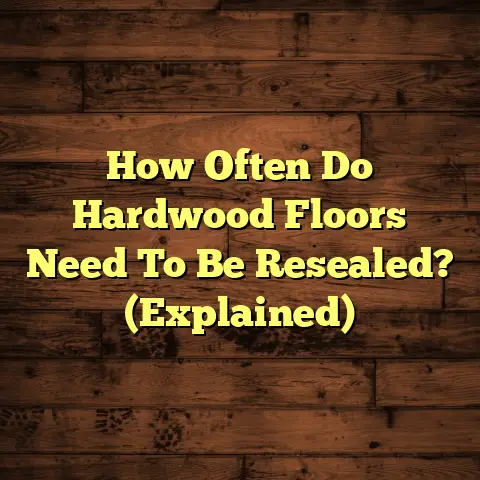Wide Plank Flooring: Dimensions Guide (4 Sizes)
I’ve seen it happen way too often.
Homeowners get swept away by the sheer beauty of wide plank flooring, completely forgetting about one crucial element: the dimensions!
It’s like falling in love with a
stunning dress without checking if it
fits.
You might end up with a visual
disaster, installation headaches, and
maintenance nightmares.
Trust me, choosing the right size is
just as important as picking the right
color or wood species.
Let’s dive in
and make sure you nail this decision!
Section 1: Understanding Wide Plank Flooring
So, what exactly is wide plank flooring?
Simply put, it’s flooring where the individual boards are significantly wider than traditional planks.
Think of it this way: traditional planks are usually around 2-4 inches wide, while wide planks start at about 6 inches and can go up to a foot or even more.
A Bit of History
Wide plank flooring isn’t some newfangled
trend.
It actually has deep historical
roots.
Back in the day, when sawmills
weren’t as advanced, it was easier and
more efficient to produce wider planks.
These wider boards were often used in colonial homes and farmhouses, giving them a rustic, charming character.
Over time, as technology improved, narrower
planks became more common.
But in recent
years, wide plank flooring has made a huge
comeback, thanks to its ability to create
a sense of spaciousness and add a touch of
luxury to any home.
Material Choices
Now, let’s talk materials. Wide plank flooring comes in a variety of options:
Hardwood: The classic choice, offering durability and timeless beauty. Think oak, maple, hickory, and walnut.
Engineered Wood: This is made up of layers of wood with a hardwood veneer on top. It’s more stable than solid hardwood, making it a good option for areas with humidity fluctuations.
Laminate: A budget-friendly option that mimics the look of wood. It’s durable and easy to clean, but it doesn’t have the same warmth and character as real wood.
Section 2: Why Size Matters
Okay, so we know what wide plank flooring is.
But why does the size of the planks matter so much?
Well, it all comes down to how the dimensions affect the perception of your space, the light, and the overall design.
Space Perception: Wider planks can make a room feel larger and more open. The fewer seams you see, the more seamless the floor looks.
Light: The way light reflects off wider planks can also enhance the brightness of a room.
Design Continuity: Consistent plank widths create a sense of flow and harmony throughout your home.
Room Type Matters, Too!
The size of the room should definitely influence your choice. For example:
Large, Open Spaces: Wider planks (8 inches or more) tend to work really well in these areas. They help fill the space and create a grand, luxurious feel.
Smaller, Closed-Off Areas: You might want to opt for slightly narrower planks (6-8 inches) to avoid overwhelming the room.
Installation and Durability
Don’t forget about installation!
Wider planks can be a bit trickier to install, especially if your subfloor isn’t perfectly level.
Also, keep in mind that wider planks are
more prone to expansion and contraction due
to changes in humidity.
This means you’ll
need to leave adequate expansion gaps during
installation to prevent buckling or warping.
Section 3: The Four Sizes of Wide Plank Flooring
Alright, let’s get down to the nitty-gritty and explore the four most common sizes of wide plank flooring: 6-inch, 8-inch, 10-inch, and 12-inch.
1. 6-Inch Planks
Description: 6-inch wide planks are a great starting point for wide plank flooring. They offer a nice balance between traditional and contemporary styles.
Pros:
- Versatile and suitable for most rooms.
- Easier to install than wider planks.
- Less prone to expansion and contraction.
- More affordable than wider options.
Cons:
- May not create as dramatic of a
statement as wider planks. - Can still look somewhat busy in very
small spaces.
- May not create as dramatic of a
Ideal Applications:
- Bedrooms
- Hallways
- Small living rooms
- Transitional design styles
2. 8-Inch Planks
Description: 8-inch wide planks are a popular choice for homeowners who want a more noticeable wide plank look without going overboard.
Pros:
- Creates a more spacious feel than 6-inch planks.
- Adds a touch of elegance to any room.
- Works well with a variety of design
styles.
- Creates a more spacious feel than 6-inch planks.
Cons:
- Slightly more expensive than 6-inch planks.
- Requires a more level subfloor for installation.
- Slightly more expensive than 6-inch planks.
Recommended Settings:
- Living rooms
- Dining rooms
- Entryways
- Farmhouse or contemporary designs
3. 10-Inch Planks
Description: 10-inch wide planks really start to make a statement! They’re perfect for creating a bold, eye-catching floor.
Pros:
- Creates a very open and airy feel.
- Adds a touch of luxury and sophistication.
- Works well in modern and rustic settings.
Cons:
- More expensive than narrower planks.
- Requires a very level subfloor and
professional installation. - More prone to expansion and contraction.
Design Styles:
- Modern
- Rustic
- Scandinavian
- Open-concept living spaces
4. 12-Inch Planks
Description: 12-inch wide planks are the kings (or queens!) of wide plank flooring. They’re the widest you’ll typically find, and they create a truly stunning visual impact.
Pros:
- Creates the most spacious and luxurious
feel possible. - Makes a bold design statement.
- Perfect for showcasing the natural
beauty of the wood grain.
- Creates the most spacious and luxurious
Cons:
- The most expensive option.
- Requires the most meticulous
installation. - The most prone to expansion and
contraction. - Might overwhelm smaller rooms.
Specific Rooms:
- Large living rooms
- Master bedrooms
- Lofts
- Commercial spaces
Section 4: Visualizing Size in Your Space
Okay, so you’ve got a good understanding
of the different sizes of wide plank
flooring.
But how do you know which one
is right for your home?
Here are a few tips for visualizing the different sizes in your space:
Consider Existing Design Elements: Think about your furniture, wall colors, and architectural features. Do you want the flooring to blend in or stand out?
Use Software or Apps: There are several apps and online tools that allow you to upload a photo of your room and virtually “install” different flooring options. This can be a great way to get a sense of scale.
Get Physical Samples: Order samples of different plank widths and lay them out on your floor. Live with them for a few days and see how they look in different lighting conditions.
Section 5: Practical Considerations with Dimensions
Alright, let’s talk about the practical
side of things.
The size of your wide
planks can have a significant impact on
installation, maintenance, and long-term
performance.
Subfloor Requirements: As I mentioned earlier, wider planks require a more level subfloor. Any imperfections in the subfloor can cause the planks to flex or creak.
Expansion Gaps: Remember those? Wider planks expand and contract more than narrower planks, so you’ll need to leave larger expansion gaps around the perimeter of the room. I typically recommend at least ¼ inch, but for planks wider than 10 inches, you might want to go even larger. Pro Tip: I always advise consulting the manufacturer’s instructions for specific recommendations.
Climate Fluctuations: If you live in an area with significant temperature and humidity changes, you’ll need to take extra precautions to minimize the effects of expansion and contraction. This might include using a humidifier or dehumidifier to maintain a consistent indoor climate.
Maintenance: Wider planks can be a bit more challenging to clean than narrower planks. You’ll need to use a floor cleaner that’s specifically designed for hardwood or engineered wood, and you’ll want to avoid using excessive amounts of water.
Section 6: Conclusion
Wow, we’ve covered a lot of ground!
I hope this guide has given you a better understanding of the importance of choosing the right dimensions for your wide plank flooring.
Remember, aesthetics are important, but
they’re not the only factor to consider.
By taking the time to think about the size
of your room, your design style, and the
practical considerations of installation
and maintenance, you can create a floor
that’s both beautiful and functional.
So, go forth and create the wide plank floor of your dreams!
And if you have any questions along the
way, don’t hesitate to ask.
That’s what
I’m here for!





